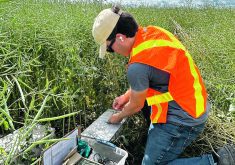This is part 2 of our three-part series on the Comprehensive Economic and Trade Agreement between Canada and the European Union. Writers from Glacier FarmMedia, which includes The Western Producer, interviewed experts to assess the value of CETA to Canada’s agricultural community.
This is part 2 of our three-part series on the Comprehensive Economic and Trade Agreement between Canada and the European Union. Writers from Glacier FarmMedia, which includes The Western Producer, interviewed experts to assess the value of CETA to Canada’s agricultural community. Stories from Parts 1 and 2 are linked below.
John Masswohl found Canadian beef for sale when he toured the central London wholesale meat market in December — but not very much.
Five boxes of Prairie Heritage beef from animals raised in Alberta and Saskatchewan were on offer beside hundreds of boxes from the United States and entire pallets from Argentina, Uruguay and Australia.
Read Also

New program aims to support plant-based exports to Asia
Understanding the preferences of consumers in Taiwan and how they differ from Indonesia or Malaysia isn’t easy for a small company in Saskatchewan.
“For every box of Canadian beef, he had at least 100 boxes from somewhere else,” said Masswohl, who is director of government and international relations for the Canadian Cattlemen’s Association.
Marketers told him Canadian beef was expensive, partly because of tariffs. Technical issues also make it difficult to acquire.
Other stories in this Special Report:
- ‘600 million opportunity’ awaits cattle sector
- Bison seen as biggest benefactor
- Doors may open but welcome mat takes time
- Dairy sector leery of EU trade
- Will EU trade reap benefits for all?
- Niche growers hope CETA will resolve GM issues
- CETA not silver bullet for European trade
That situation could change dramatically when the trade deal between Canada and the European Union, called the Comprehensive Economic Trade Agreement, comes into force.
“We’ve got an outstanding quality product and an outstanding eating experience that goes with it, and I think for a price, that would be very comparable to what Europeans are used to paying if we didn’t have to deal with all these tariffs and other conditions,” said Masswohl.
The deal will allow beef and veal exports worth an estimated $600 million and generated from 65,000 tonnes of new duty free access to Europe. About 50,000 tonnes of that is fresh beef and the balance frozen product.
Using an estimate of 100 kilograms of fresh beef available per animal, it could translate into a market for 500,000 Canadian cattle, but only f they meet the EU requirement of being raised without the use of additional growth hormones.
“How many cattle do we have in Canada being produced according to EU standards, or could be if they were properly documented? I’d only be taking a guess … but I think right now, today, somewhere less than 100,000 head,” Masswohl said.
“But with the incentive there, I’ve talked to lots of guys that say, ‘if the incentive is there, I’ll do it.’ ”
Feedlot owner Rick Pascal of Picture Butte, Alta., isn’t so sure the incentive will be enough to encourage more production of beef that meets EU specifications.
“They don’t recognize the science of the day, so we’ve got these free trade agreements with them, but it’s still just the same. We don’t meet their criteria for trade, which is not science based,” he said.
“I don’t understand why we would have negotiated an agreement like this. It sounds like we’ve got an opportunity to put Canadian beef in Europe, but we don’t and we never will.”
Paskal said use of growth hormones reduces beef production costs by $250 per head through better feed conversion and shorter time to fatten. Price premiums offered in Europe for beef free of added hormones would have to cover that, and he thinks it is unlikely.
“It’s good that all the people around the world get talking to one another and they want to expedite trade and reduce trade barriers, but they’ve got to go back and … really, if there’s a spirit of trade, just address the science.
“It’s got nothing to do with food safety. We’re all big proponents of food safety, your product, your animal handling, the animal welfare aspects are very, very important. We’re not saying we’re ever going to circumvent them, but it’s got to be based on science.”
Doug Price, who runs Sunterra’s beef operations, said he sees opportunity through CETA for more beef exports, but the price has to be right.
“We have the cows and the feedlots,” he said.
“I’ve got a pretty good handle on what it costs me to produce non-hormone, traceable cattle. It’s really easy for us to do that, but I need to know how much premium will I get for that before I do it.”
Price said opportunities in Europe might better suit smaller, more nimble operations that can cater to higher end niche markets.
“If we get some of our product over there, I think they’ll pay quite a premium for it. So I think the opportunity, for sure, is there. We just have to put all the pieces together,” said Price.
“Our genetics here in Canada and our technology inside the cow-calf right through to the feedlot to the plant is as good as anybody in the world, and I think the genetics are even better. There’s less variability. So any kind of a quality market, man, we’re sitting real good there.”
Producers who work with Prairie Heritage Beef have been meeting EU requirements and building their niche for years but on a small scale.
Before selling the brand to One Earth Farms in October 2014, Prairie Heritage was selling beef from 5,000 animals to Europe and another 5,000 domestically, said former president Cliff Drever of Camrose.
Christoph Weder, a cattle and bison producer in Hudson’s Hope, B.C., was the primary marketer for the branded beef line before its sale. In his view, Canadian producers won’t be able to fill the entire EU quota unless the two major packers in Western Canada, JBS and Cargill, develop a way to separate hormone-free and commercial beef.
He and others hold out hope that Harmony Beef, the former Rancher’s Beef processing plant in Balzac, Alta., will open soon. It is expected to market specialty beef into Europe.
The Balzac plant would add to output provided by Canadian Premium Meats in Lacombe, Alta., another EU approved facility.
However, Harmony Beef has been beset by water issues and other objections from the City of Calgary and has yet to start operation.
Producers with an eye to producing beef for Europe must meet specific requirements subject to Canadian Food Inspection Agency oversight.
Jason Hagel, a Three Hills, Alta., producer with Prairie Heritage, said those re-quirements might be enough to discourage greater production.
“I don’t think it will change much,” said Hagel. “The program that Canada has in place is very onerous on producers who actually want to do it, with all the paperwork and CFIA vets having to come and make sure everything’s in place.
Certain quotas and high tariffs remain in place until CETA goes into effect, so few producers are raising animals with a view to the EU market.
“Right now, it’s not worth it because you’re not getting any more money by doing that, as a cow-calf producer, than taking them to the market and just selling them in the open market,” said Hagel.
He said One Earth can’t afford to pay much more than the commodity market because any premium from Europe doesn’t cover the extra cost involved in producing the beef.
He also wonders if December’s repeal of country-of-origin labelling in the United States, which used to discourage Canadian cattle sales, will prompt producers and packers to take that easier path.
“We have two American packing plants in Canada,” Hagel said. “They have pretty good connections in the States and can move the beef easier. They’re not going to chase after a market that has to change the way they do business in their own plants and cost a lot more.”
And speaking of plants, the safety methods employed by Canada’s major packers have yet to meet the approval of the EU. That’s another hurdle that must be overcome before Canadian beef benefits from CETA.
These technical considerations are not part of the CETA agreement, but they exist in a side arrangement that says the two parties will work toward equivalence in their respective meat inspection systems.
Masswohl said that equivalence has yet to emerge.
“Our idea of equivalence means that we can do things our way, they can do things their way. Not everything needs to be harmonized, but the end result, the outcome, is equivalent in that we both produce safe beef,” he said.“What we’ve learned is Europe’s idea of equivalence is they want us to do it their way. But we’re not doing it their way. Our way is much safer.”
Canadian plants use antimicrobial carcass washes and safety techniques after cattle are slaughtered to destroy E. coli and other bacteria. Europe does not use the same methods.
The big three plants in Canada process more than 90 percent of the country’s beef. The volume of animals, the distance they travel and the weather all play a role in sanitary and phytosanitary considerations at the plants.
Europe, in contrast, has hundreds of slaughter facilities, many of them processing small numbers of animals delivered in small trucks from nearby locations.
“They say the animal needs to be clean before it comes into the slaughter facility,” said Masswohl. “So how does that work in our scenario where we have much colder temperatures to deal with for much longer periods of the year? The idea of washing animals outside when it’s below -20 … it doesn’t seem like humane treatment for the animal. It seems impractical.”
Europe has agreed to the use of lactic acid as a sanitary measure and more recently approved the use of recycled hot water. However, approval will be needed for other safety related treatments that have become standard in Canadian plants.
“They just don’t do any of that, and they just can’t fathom doing anything else,” said Masswohl. “We rather suspect that they like the system the way it is because it keeps imported beef out of their market. We rather suspect that that’s a big part of the motivation for the way they do it.… If we don’t resolve this, then the (CETA) agreement is of very little value for the Canadian beef industry. If we do resolve it, it’s huge value for us. It’s worth working on.”
Before it heads to market
Canadian feedlot operators interested in producing animals for the European Union market under the Comprehensive Economic and Trade Agreement must follow specific protocols. Here is a partial list of what is required:
- The operation must be assessed by Canadian Food Inspection Agency-approved veterinarian.
- Written program is needed outlining organizational structure.
- Enrolment form and declaration of compliance is required annually.
- Maintenance of an organizational chart indicating who is responsible for various tasks, with records showing how and when training was delivered to those who perform a task.
- If growth enhancing products (GEPs) are used in some part of the operation, a tracking system is needed, as well as alternate identifiers for animals given GEPs, such as different colour or tag type.
- Feeds or supplements from a commercial feed mill require a letter from that feed mill certifying absence of GEPs.
- Cattle designated for the EU can come to a feedlot only from other premises enrolled in the program. On arrival, animals’ identities must be confirmed.
- If evidence of implant detected in animal arriving at the feedlot, CFIA veterinarian must be immediately notified.
- Specific transfer documents are needed when animals are moved.
- Animals cannot be commingled at the auction market with animals not enrolled in program.


















